1996 CHEVROLET BLAZER maintenance schedule
[x] Cancel search: maintenance schedulePage 269 of 392

Downloaded from www.Manualslib.com manuals search engine What to Use
Refer to the Maintenance Schedule to determine what
kind of lubricant to use. See “Recommended Fluids and
Lubricants” in the Index.
Front Axle
When to Check and Change Lubricant
Refer to the Maintenance Schedule to determine how
often to check the lubricant and when to change it. See
“Scheduled Maintenance Services” in the Index.
How to Check Lubricant
If the level is below the bottom of the filler plug hole,
you’ll need
to add some lubricant.
If the differential is at operating temperature (warm),
add enough lubricant
to raise the level to the bottom of
the filler plug hole.
If the differential is cold, add enough lubricant to raise
the level to
1/2 inch (12 mm) below the filler plug hole.
6-21
Page 270 of 392
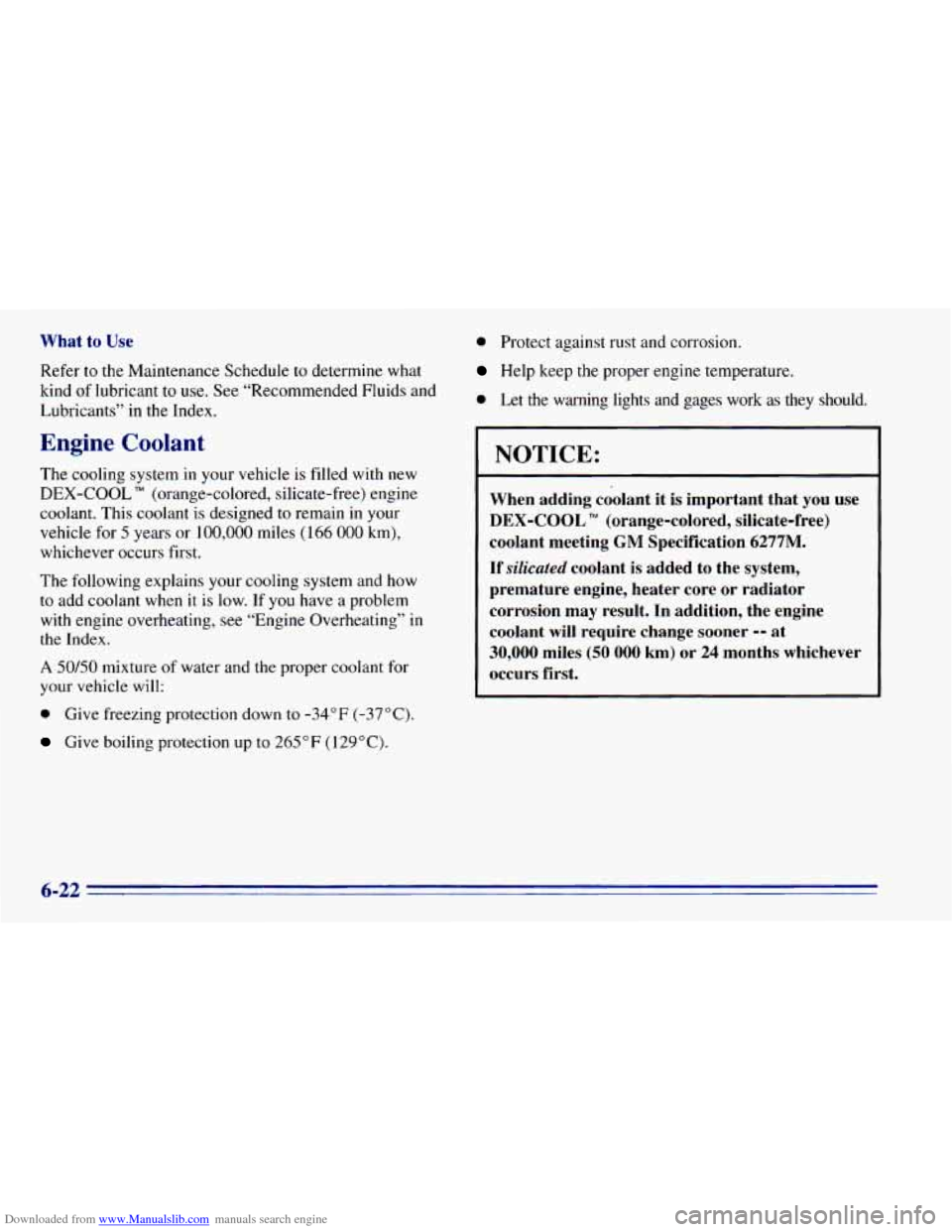
Downloaded from www.Manualslib.com manuals search engine What to Use
Refer to the Maintenance Schedule to determine what
kind of lubricant to use. See “Recommended Fluids and
Lubricants” in the Index.
Engine Coolant
The cooling system in your vehicle is filled with new
DEX-COOL TM (orange-colored, silicate-free) engine
coolant. This coolant is designed to remain
in your
vehicle for
5 years or 100,000 miles (166 000 km),
whichever occurs first.
The following explains your cooling system and how
to add coolant when
it is low. If you have a problem
with engine overheating, see “Engine Overheating” in
the Index.
A 50/50 mixture of water and the proper coolant for
your vehicle will:
0 Give freezing protection down to -34°F (-37 “C).
Give boiling protection up to 265 “F (129°C).
0 Protect against rust and corrosion.
Help keep the proper engine temperature.
0 Let the warning lights and gages work as they should.
I 1
NOTICE:
When adding coolant it is important that you use
DEX-COOL TM (orange-colored, silicate-free)
coolant meeting
GM Specification 6277M.
If silicated coolant is added to the system,
premature engine, heater core or radiator
corrosion may result. In addition, the engine coolant
will require change sooner -- at
30,000 miles (50 000 km) or 24 months whichever
occurs first.
6-22
Page 274 of 392
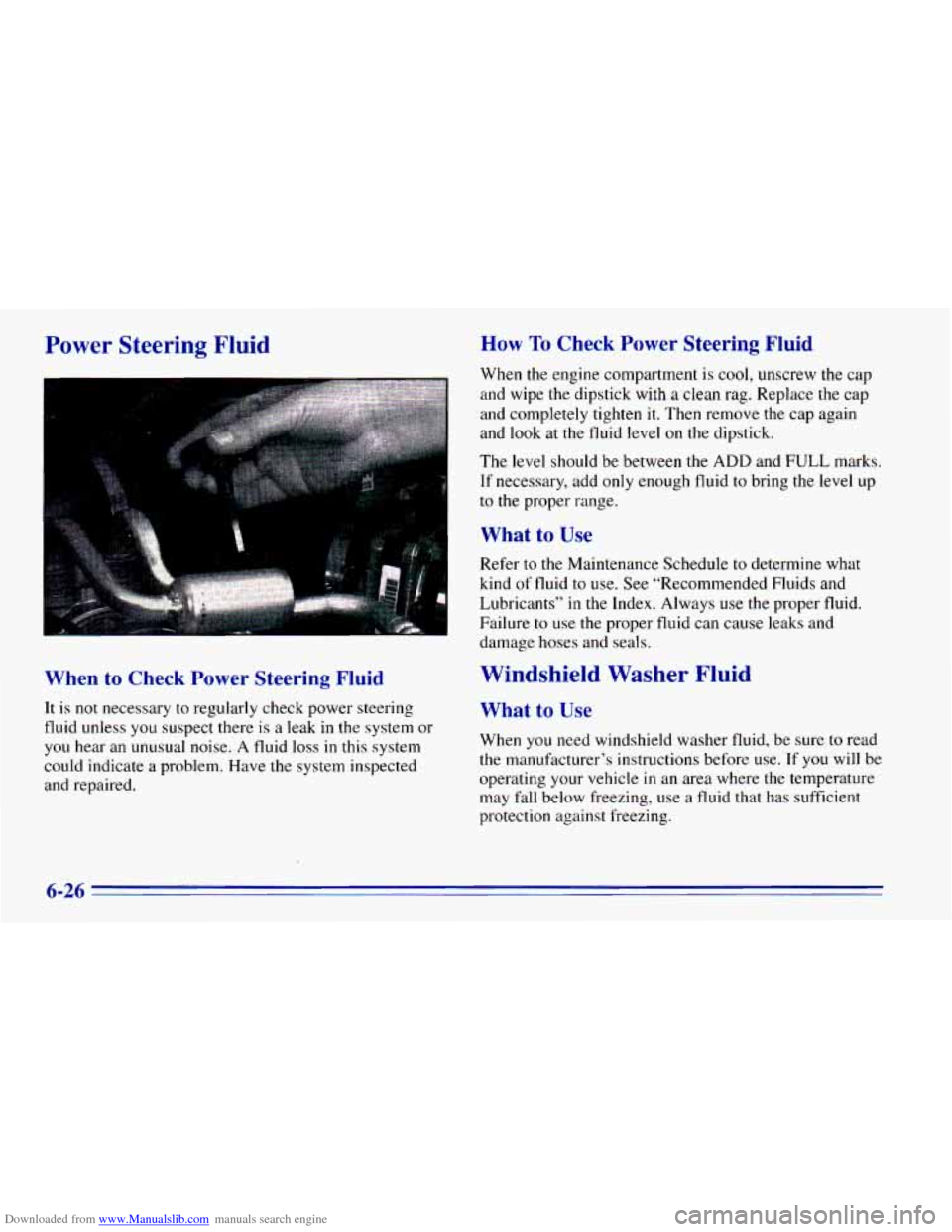
Downloaded from www.Manualslib.com manuals search engine Power Steering Fluid
When to Check Power Steering Fluid
It is not necessary to regularly check power steering
fluid unless you suspect there
is a leak in the system or
you hear an unusual noise.
A fluid loss in this system
could indicate a problem. Have the system inspected
and repaired.
How To Check Power Steering Fluid
When the engine compartment is cool, unscrew the cap
and wipe the dipstick
with a clean rag. Replace the cap
and completely tighten it. Then remove the cap again
and look at the fluid level on the dipstick.
The level should be between the
ADD and FULL marks.
If necessary, add
only enough fluid to bring the level up
to the proper range.
What to Use
Refer to the Maintenance Schedule to determine what
kind
of fluid to use. See “Recommended Fluids and
Lubricants”
in the Index. Always use the proper fluid.
Failure to use the proper fluid can cause leaks and
damage hoses and seals.
Windshield Washer Fluid
What to Use
When you need windshield washer fluid, be sure to read
the manufacturer’s instructions before use. If you will be
operating your vehicle
in an area where the temperature
may fall below freezing, use a fluid that
has sufficient
protection against freezing.
6-26
Page 276 of 392
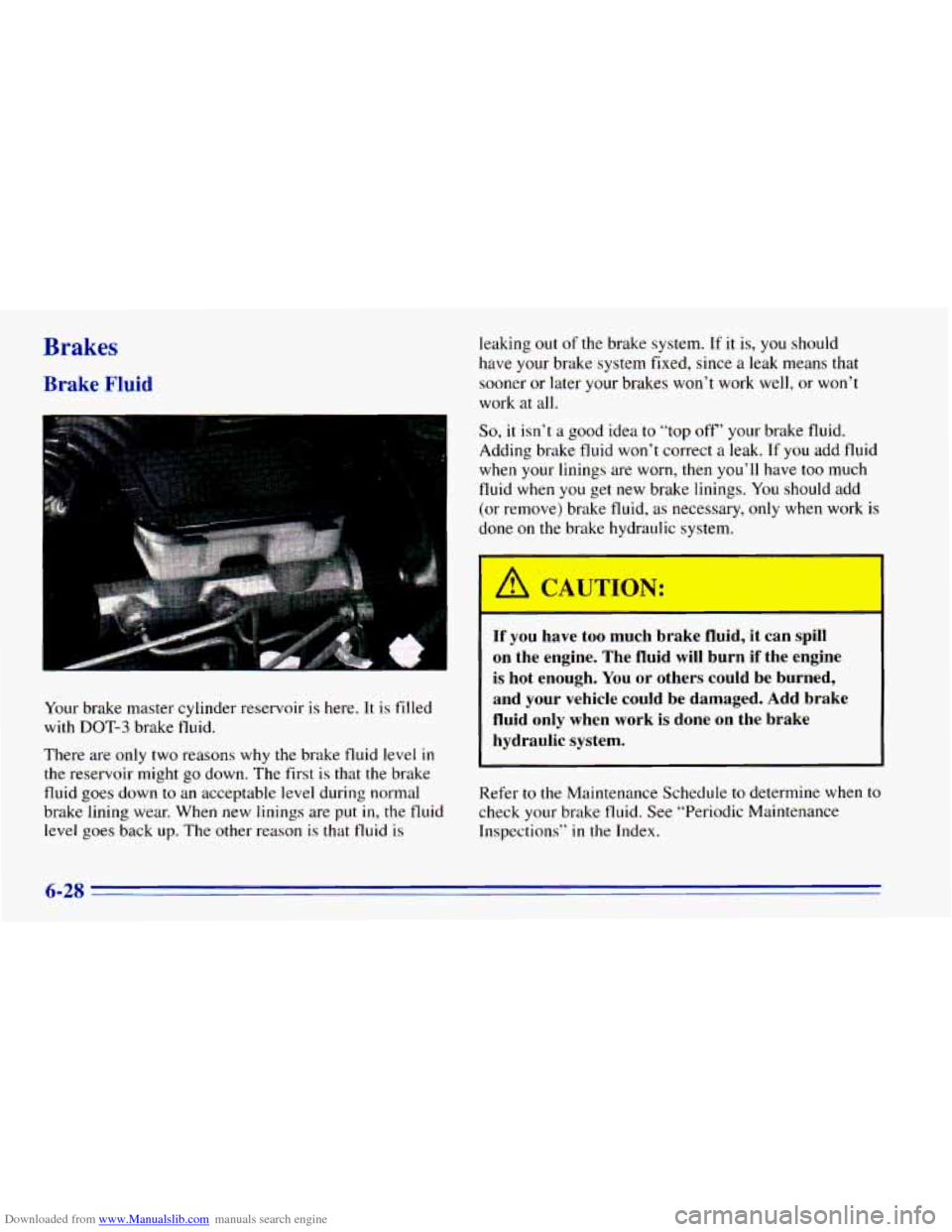
Downloaded from www.Manualslib.com manuals search engine Brakes
Bra.ke Fluid
Your brake master cylinder reservoir is here. It is filled
with
DOT-3 brake fluid.
There are only two reasons why the brake fluid level
in
the reservoir might go down. The first is that the brake
fluid goes down
to an acceptable level during normal
brake lining wear. When new linings are
put in, the fluid
level goes back up. The other reason
is that fluid is
leaking out of the brake system. If it is, you should
have your brake system fixed, si.nce
a leak means that
sooner or later your brakes won’t work well, or won’t
work at all.
So, it isn’t a good idea to “top off’ your brake fluid.
Adding brake fluid won’t correct a leak. If
you add fluid
when your linings are worn,
then you’ll have too much
fluid when
you get new brake linings. You should add
(or remove) brake fluid, as necessary, only when work
is
done on the brake hydraulic system.
I A CAUTION:
If you have too much brake fluid, it can spill
on the engine. The fluid
will burn if the engine
is hot enough. You or others could be burned,
and your vehicle could be damaged. Add brake
fluid only when work is done on the brake
hydraulic system.
Refer to the Maintenance Schedule to determine when to
check your brake fluid. See “Periodic Maintenance
Inspections’’
in the Index.
6-28
Page 291 of 392
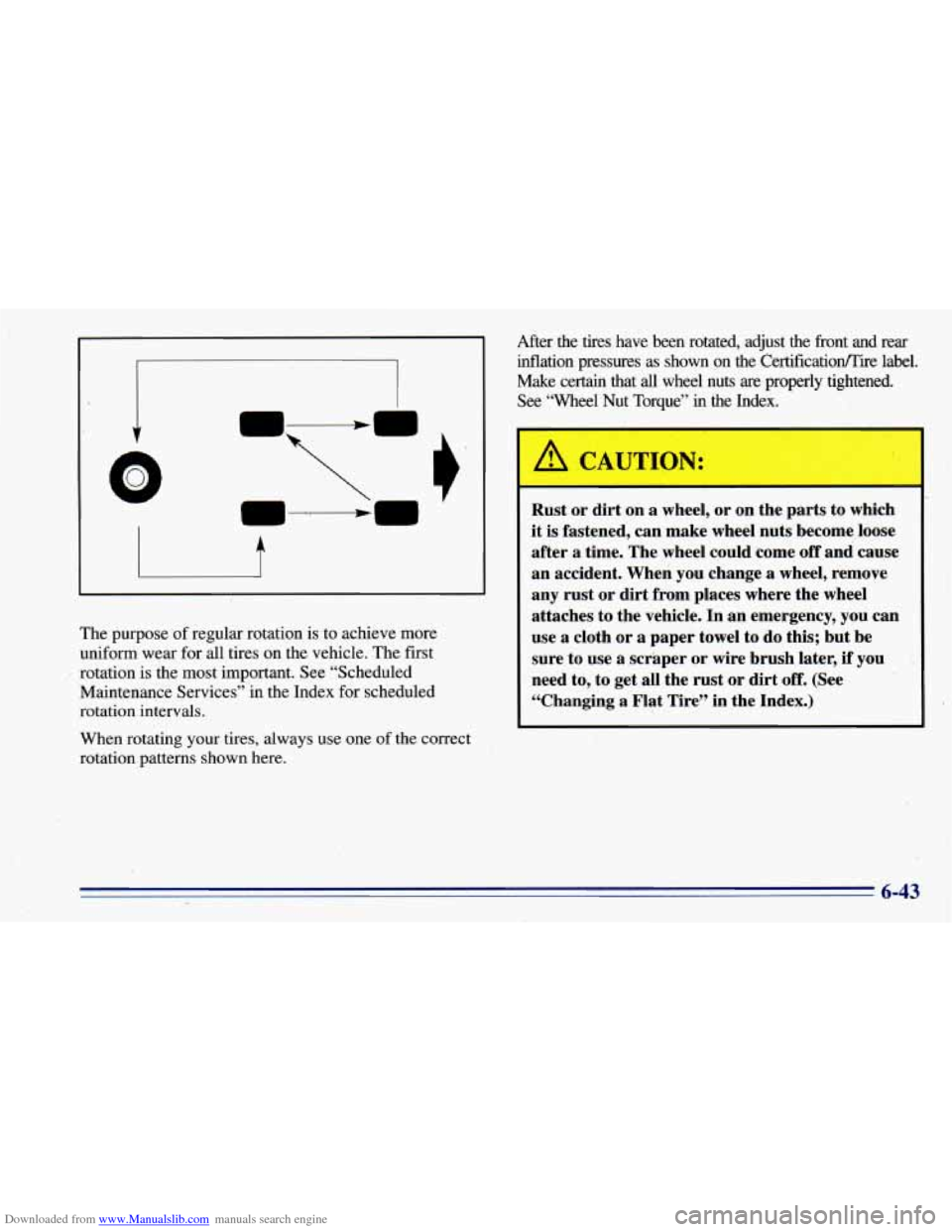
Downloaded from www.Manualslib.com manuals search engine c
f
The purpose of regular rotation is to achieve more
uniform wear for all tires on the vehicle. The first
Maintenance Services” in the Index for scheduled
rotation intervals.
I rotation is the most important. See “Scheduled
When rotating your tires, always use one of the correct
rotation patterns shown here. After the tires have been rotated, adjust the front and rear
inflation pressures as shown on the
Certificatioflire label.
Make certain that
all wheel nuts are. properly tightened.
See “Wheel Nut Torque’’
in the Index.
Rust or dirt on
a wheel, or on .the parts to Which
it is fastened, can make wheel nuts become loose
after
a time. The wheel could come off and cause
an accident. When you change
a wheel, remove
any rust or dirt from places where the wheel
attaches to the vehicle. In an emergency, you can
use
a cloth or a paper towel to do this; but be
sure to use
a scraper or wire brush later, if you
need to, to get all the rust or dirt
off. (See
“Changing
a Flat Tire” in the Index.)
-_
6-43
Page 313 of 392

Downloaded from www.Manualslib.com manuals search engine Section 7 Maintenance Schedule
IMPORTANT-
KEEP ENGINE OIL
AT THE PROPER
LEVEL AND CHANGE AS
RECOMMENDED
This section covers the maintenance required for your
vehicle. Your vehicle needs these services to retain its
safety, dependability and emission control performance.
es
Protection
Plan
Have you purchased the GM Protection Plan? The Plan
supplements
your new vehicle warranties. See your
Warranty and Owner Assistance booklet, or your GM
dealer for details.
Introduction
Your Vehicle and the Environment
Proper vehicle maintenance not only helps to keep your
vehicle
in good working condition, but also helps the
environment. All recommended maintenance procedures
are important. Improper vehicle maintenance can even
affect the quality of
the air we breathe. Improper fluid
levels or
the wrong tire inflation can increase the level
of emissions from your vehicle.
To help protect our
environment, and to keep your vehicle
in good
condition, please maintain your vehicle properly.
7-1
Page 314 of 392
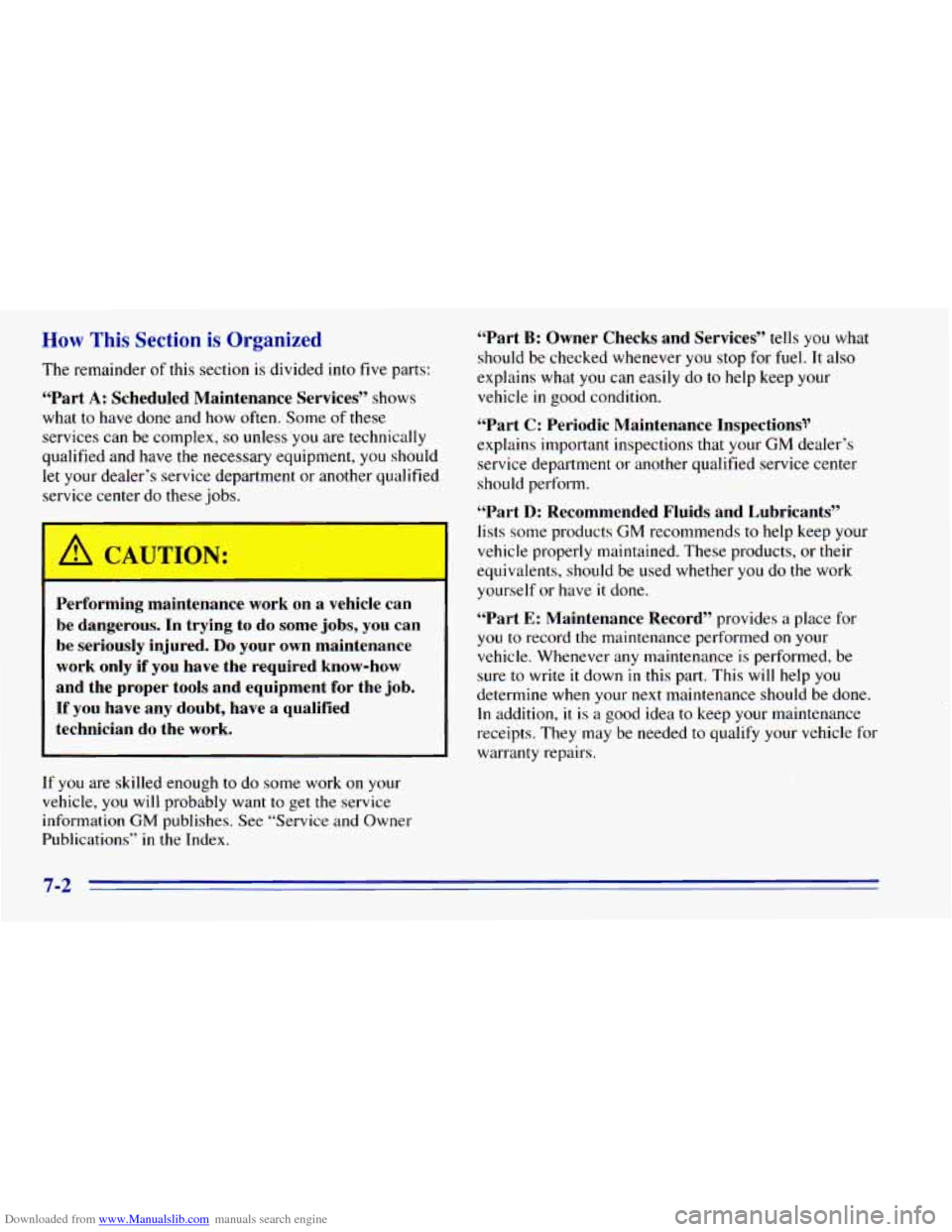
Downloaded from www.Manualslib.com manuals search engine How This Section is Organized v
The remainder of this section is divided into five parts:
“Part
A: Scheduled Maintenance Services” shows
what to have done and
how often. Some of these
services can be complex,
so unless you are technically
qualified and have
the necessary equipment, you should
let your dealer’s service department or another qualified
service center do these
jobs.
Performing maintenance work on a vehicle can
be dangerous. In trying
to do some jobs, you can
be seriously injured. Do your own maintenance
work only if you have the required know-how
and the proper tools and equipment for the
job.
If you have any doubt, have a qualified
technician do the work.
If you are skilled enough to do some work on your
vehicle,
you will probably want to get the service
information
GM publishes. See “Service and Owner
Publications’’ in the Index. “Part
B: Owner Checks and
Services” tells you what
should be checked whenever
you stop for fuel. It also
explains what you can easily do to help keep your
vehicle
in good condition.
“Part
C: Periodic Maintenance Inspections?’
explains important inspections that your
GM dealer’s
service department or another qualified service center
should perform.
“Part
D: Recommended Fluids and Lubricants”
lists some products
GM recommends to help keep your
vehicle properly maintained. These products, or their
equivalents, should be used whether you do
the work
yourself or have
it done.
“Part
E: Maintenance Record’’ provides a place for
you
to record the maintenance performed on your
vehicle. Whenever any maintenance
is performed, be
sure to write
it down in this part. This will help you
determine when
your next maintenance should be done.
In addition, it is a good idea to keep your maintenance
receipts. They may be needed to qualify your vehicle for
warranty repairs.
7-2
Page 315 of 392

Downloaded from www.Manualslib.com manuals search engine Part A: Scheduled Maintenance
Services
Using Your Maintenance Schedule
We at General Motors want to help you keep your
vehicle in good working condition. But
we don’t know
exactly bow you’ll drive it. You may drive very short
distances
only a few times a week. Or you may drive
long distances
all the time in very hot, dusty weather.
You may use your vehicle
in making deliveries. Or
you may drive it to work, to do errands or
in many
other ways.
Because
of all the different ways people use their GM
vehicles, maintenance needs vary.
You may even need
more frequent checks and replacements than you’ll find
in the schedules
in this section. So please read this
section and note how you drive.
If you have any
questions on
how to keep your vehicle in good
condition, see your
GM dealer.
This part tells
you the maintenance services you should
have done and when
you should schedule them. If you
go to your dealer for your service needs, you’ll know
that GM-trained and supported service people will
perform the work using genuine
GM parts. The
proper fluids and lubricants
to use are listed in
Part D. Make sure whoever services your vehicle
uses these. All parts should be replaced and all
necessary repairs done before
you or anyone else
drives the vehicle.
These schedules are for vehicles
that:
carry passengers and cargo within recommended
limits. You will find these limits
on your vehicle’s
CertificationEire label. See “Loading Your Vehicle”
in the Index.
are driven on reasonable road surfaces within legal
driving limits.
0 are driven off-road in the recommended manner. See
“Off-Road Driving With Your Four-Wheel-Drive
Vehicle’’ in the Index.
use the recommended fuel. See “Fuel” in the Index.
Selecting the Right Schedule
First you’ll need to decide which of the two schedules is
right
for your vehicle. Here’s how to decide which
schedule
to follow:
7-3